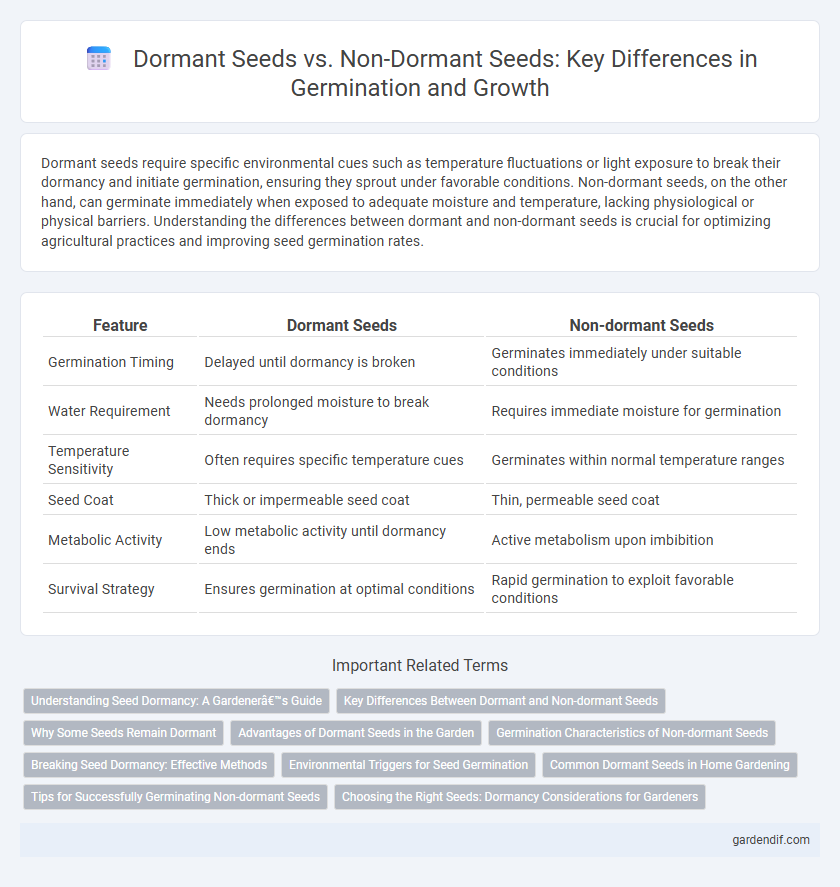
Dormant Seeds vs Non-dormant Seeds Illustration
Dormant seeds require specific environmental cues such as temperature fluctuations or light exposure to break their dormancy and initiate germination, ensuring they sprout under favorable conditions. Non-dormant seeds, on the other hand, can germinate immediately when exposed to adequate moisture and temperature, lacking physiological or physical barriers. Understanding the differences between dormant and non-dormant seeds is crucial for optimizing agricultural practices and improving seed germination rates.
Table of Comparison
| Feature | Dormant Seeds | Non-dormant Seeds |
|---|---|---|
| Germination Timing | Delayed until dormancy is broken | Germinates immediately under suitable conditions |
| Water Requirement | Needs prolonged moisture to break dormancy | Requires immediate moisture for germination |
| Temperature Sensitivity | Often requires specific temperature cues | Germinates within normal temperature ranges |
| Seed Coat | Thick or impermeable seed coat | Thin, permeable seed coat |
| Metabolic Activity | Low metabolic activity until dormancy ends | Active metabolism upon imbibition |
| Survival Strategy | Ensures germination at optimal conditions | Rapid germination to exploit favorable conditions |
Understanding Seed Dormancy: A Gardener’s Guide
Dormant seeds exhibit physiological or physical barriers that prevent germination despite favorable conditions, requiring specific triggers like cold stratification or scarification to break dormancy. Non-dormant seeds can germinate immediately when exposed to moisture and optimal temperature without additional treatment. Understanding these differences helps gardeners implement effective strategies to synchronize germination and improve seedling establishment.
Key Differences Between Dormant and Non-dormant Seeds
Dormant seeds contain physiological or physical barriers preventing germination despite favorable conditions, whereas non-dormant seeds germinate immediately once environmental requirements such as moisture, temperature, and oxygen availability are met. Dormancy in seeds is regulated by factors like hormone levels, seed coat thickness, and temperature sensitivity, providing survival advantages by timing germination. Non-dormant seeds lack these restrictions, leading to quicker germination cycles but potentially reduced environmental resilience.
Why Some Seeds Remain Dormant
Some seeds remain dormant due to physiological, morphological, or environmental factors that prevent germination until conditions are favorable. Dormancy mechanisms include hard seed coats, presence of growth inhibitors, or requirement for specific temperature or light cues. These adaptations enhance survival by timing germination to optimal environmental conditions.
Advantages of Dormant Seeds in the Garden
Dormant seeds exhibit enhanced longevity and survivability by delaying germination until environmental conditions are optimal, reducing the risk of seedling failure. This natural adaptation allows gardeners to plan sowing schedules more effectively, ensuring seedling establishment aligns with favorable growth periods. The ability of dormant seeds to withstand adverse conditions supports biodiversity and maintains seed viability over extended storage times.
Germination Characteristics of Non-dormant Seeds
Non-dormant seeds exhibit immediate germination under favorable environmental conditions due to the absence of physiological or physical dormancy mechanisms. These seeds typically have fully developed embryos and permeable seed coats, allowing rapid water absorption and enzymatic activation necessary for germination. The germination rate of non-dormant seeds is significantly higher compared to dormant seeds, enabling quicker seedling establishment and growth.
Breaking Seed Dormancy: Effective Methods
Breaking seed dormancy involves techniques such as scarification, stratification, and chemical treatments that enhance water absorption and enzymatic activity essential for germination. Scarification, which includes mechanical or acid-induced abrasion of the seed coat, effectively increases permeability, while stratification mimics natural cold or warm periods to trigger metabolic processes. Chemical treatments using substances like gibberellic acid stimulate hormonal changes, making these methods critical for converting dormant seeds into actively germinating ones.
Environmental Triggers for Seed Germination
Dormant seeds require specific environmental triggers such as temperature fluctuations, light exposure, or moisture changes to break dormancy and initiate germination. Non-dormant seeds can germinate immediately when exposed to favorable conditions like adequate water, oxygen, and optimal temperature. Understanding these triggers is crucial for optimizing seed germination rates in agricultural and ecological applications.
Common Dormant Seeds in Home Gardening
Common dormant seeds in home gardening include peas, beans, and lettuce, which require specific conditions such as stratification or scarification to break dormancy and initiate germination. These seeds have inherent physiological or physical barriers that prevent immediate sprouting, ensuring seedlings emerge during favorable environmental conditions. Understanding the dormancy mechanisms of these seeds enables gardeners to optimize germination rates and improve plant establishment.
Tips for Successfully Germinating Non-dormant Seeds
Non-dormant seeds require consistent moisture and optimal temperature conditions, typically between 65degF to 75degF, to trigger rapid germination. Using a seed-starting mix with good drainage prevents waterlogging and promotes oxygen availability, essential for seed metabolism. Maintaining a stable environment with adequate light exposure ensures vigorous seedling growth after emergence.
Choosing the Right Seeds: Dormancy Considerations for Gardeners
Dormant seeds require specific environmental triggers such as temperature fluctuations or scarification to break dormancy and initiate germination, making them ideal for gardeners aiming to synchronize seedling emergence with optimal growing conditions. Non-dormant seeds germinate rapidly under suitable moisture, temperature, and light, providing quicker results but less control over timing. Selecting the right seed type depends on the gardener's goal for growth timing, climate adaptability, and desired seedling vigor.
Dormant Seeds vs Non-dormant Seeds Infographic

 gardendif.com
gardendif.com